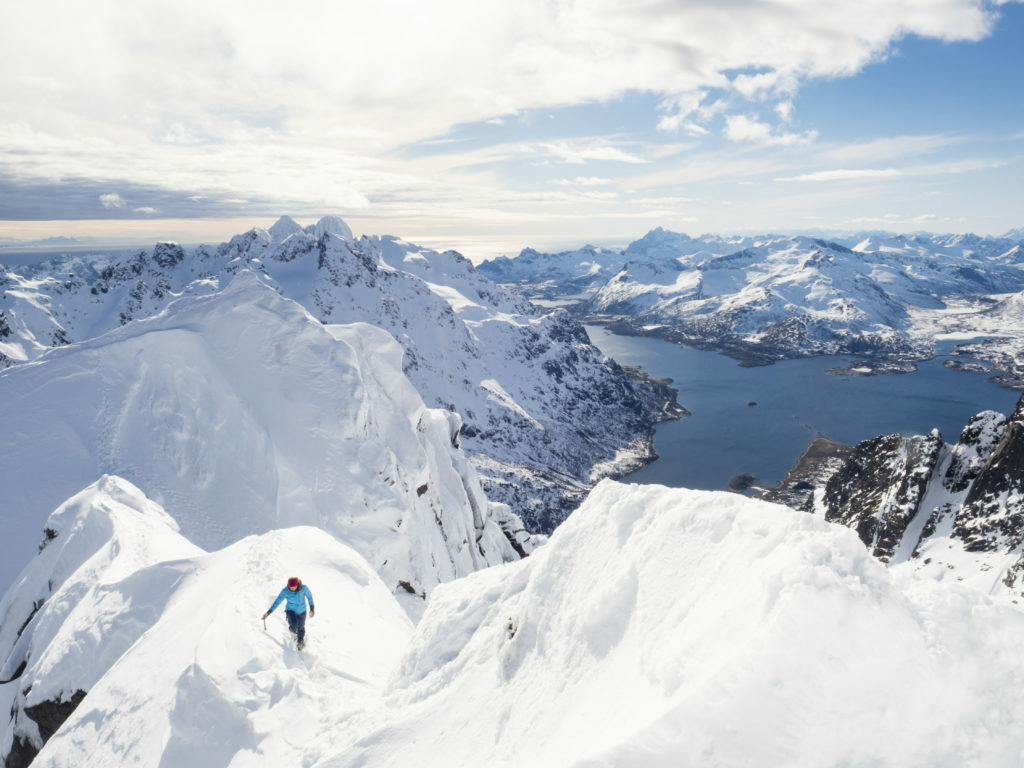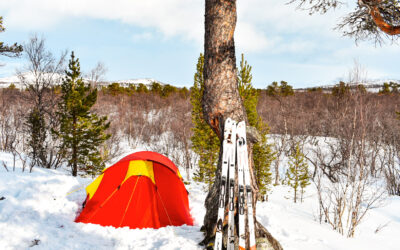
Written by
Kristin Folsland Olsen
Freelance journalist, photographer and lecturer living in Lofoten. She has published several books, including Baffin Babes, which was filmed and broadcast on NRK. In addition, she has been a programme manager on the Discovery Channel. Kristin has carried out skiing expeditions on Svalbard, Greenland, Baffin Island and South Georgia. She continues to write for magazines such as A-magasinet and Fjell og Vidde.
Snap decisions
You won’t have pictures to brag if you leave your camera packed away in your bag, no matter how fancy it is. Having it easily accessible is the most important thing for anyone who wants to make memorable images.
What kind of camera should you choose?
The camera in your phone is probably excellent. Small-lens optics and image capture are excellent today. This is often sufficient for those of us who aren’t interested in learning about technique, and who are content to concentrate on composing the image, pressing the shutter button, and then letting the camera do the rest. For ambitious travel photographers, mirrorless system cameras with replaceable optics are an excellent choice. These cameras are considerably lighter and smaller than SLR cameras, and are therefore much easier to handle on trips.
Camera settings
Using the auto setting on the camera can lead to great results. But if you want to have more control over the images, you should learn the basics of photographic theory – the relationship between aperture, shutter and ISO. If you have an understanding of how these factors interact, this increases the possibilities for creative images of quality.
Practical tips
Make sure you always have a fully charged battery and capacity on the memory card before you head out for the hills. If you are going to take a lot of photos, or be on a multi-day tour, you should bring a spare. In winter, the batteries drain quickly, and it pays to store extra batteries in a warm place like an inner pocket. Always have a cleaning cloth readily available to clean the lens. This is particularly relevant in snowy or rainy weather.Attention! Attention!
To capture the most exciting subjects, you need to be vigilant. Assess situations and stay ahead of events. If the tour party has to cross a stream, make sure to be the first person to cross; be ready with the camera when the others arrive. Is it permissible to hope for a little drama? For art’s sake!
Be mobile – use different perspectives
Be mobile. Find a different perspective when taking pictures. Don’t just stand straight up; lie down on your stomach; climb in the terrain to find exciting viewing angles. A camera with a screen you can angle is helpful in situations like this.

Examples of using perspective to give the image that little something extra.
Photo: Kristin Folsland Olsen

Here’s an example of the use of height and perspective to give the picture an interesting angle.
Photo: Kristin Folsland Olsen
Take pictures when it’s grim
Grim weather is photo weather. When dark clouds roll in and the sky opens up, or when you and your hiking companions are cold and tired, there’s an opportunity to take dramatic and exciting photos. Most people take sunny pictures, leaving the camera unused in a snowstorm or downpour. But these can quickly become the most interesting photos, so be alert when the weather turns bad. Åsnes loves such pictures; these are the ones that reflect reality.

Composition
Composing your image, the rule of thirds is a good starting point. Using an imaginary grid with nine equally sized squares made by two equally spaced horizontal and vertical lines, the main motif is placed in one of the four points where the lines cross. You can also situate the elements of the image so that they have room around them. If a travel companion in your image is gazing at something, for example, compose the picture so that there’s space in the direction the person is looking

Many cameras also overlay a grid on the screen or viewfinder. Use it until this comes naturally to you.
Photo: Kristin Folsland Olsen

Room in the direction of gaze.
Foto: Kristin Folsland Olsen
Using lines
Lines are a good tool when composing a picture. The eye instinctively follow lines, making them useful for drawing the viewer’s attention where you want it. Repetitive geometric shapes can also create an exciting dynamic in the composition. Having the horizon level is something else to think about – provided omitting it is not a deliberate move. The view may otherwise get seasick! Again, many cameras have guide lines in the viewfinder and on the screen to help you get the right horizon – see the example above.

Tidy up
When we take pictures, we tend to be so absorbed by the main subject that we forget the details or the overall effect. Think about tidying up. If you’re taking a tour-portrait, make sure there are no unwanted elements like ski poles or branches directly behind the model so that it looks like horns are growing out of their head. Move the poles or move yourself to a different perspective. Maybe even take a different view altogether.

Including elements in the very foreground can give an image more depth. Get to your knees and bring a colourful flower or a flowing stream into the foreground when you take a picture of a mountain hiker.

Light
The verb “to photograph” literally means “to inscribe with light”. Both the direction and character of the light are important. Early and late in the day, when the sun is low in the sky, the light is soft and warm. These are great conditions for photography. The high, bright, mid-day sun leads to strong contrasts. Dark parts of the image may become too dark while bright parts may be completely burned out. Lighting the subject from the front does not necessarily offer complications. But the disadvantage is that the images tend to be become somewhat “flat”, even boring. Be sure to avoid your own shadow falling into the frame. Side lighting often brings more life to the subject by creating clear shadows. Photography in backlight provides great contrasts. In backlight, you can take nice silhouettes, or play with shadows. It’s also possible to include the sun in the picture. To get a star effect with rays from the sun, use a small aperture (that is, high number).

Practice makes a perfect photographer!
As with most things, practice is a prerequisite to becoming a good photographer. Get to know your equipment so that you know where the various settings are when you need them. Everything should all “at your fingertips”. If you have fun with photography, you’re on the right track. Play with the camera. Try out new subjects and angles. Check out other people’s photographs. You can learn a lot that way. Find out why you like something about an image and take the lessons with you when developing your own visual language.


Presentation
When you’re going to present your pictures, cast a critical eye on what you show. An important part of the work with images is selecting images to tell the story you want. Be sure to include detailed images, portraits, activity pictures and large overviews – this creates a good dynamic in the narrative.
Social media is a great way to get inspiration and to show off your photos.
Follow inspiring photographers and outdoor people. You can start with the author of this very article!

Menstruating on skis
Periods. Because we menstruate in winter too. Stomach cramps while overnighting in the wild aren’t often discussed – which means they ought to be. So curl up with some ibuprofen and a glass of water for some good tips for menstruating in the winter mountains.
Hot waxing skins
Hot waxing skins? Yes. That’s right. The rumours are true: you can wax skins. With glide wax. And an iron. And for alpine touring, it works a total treat.

Packing a pulk
A quick introduction to packing a pulk. And a few words about the wonderful combination of pulk and skins. We’re having fun in pack-a-pulk-o!

Clothes for dogs in the cold
When it gets cold, spare a thought for you dog. Even dogs with a lot of fur can freeze if they don’t have an insulating undercoat. It doesn’t actually have to be much colder than -5° before many dogs can have problems – but there are still some who think dogs are unfreezeable. Here’s how to make sure they don’t.

Waxing and prepping alpine touring skis
We don’t put in all that effort just for the view. We do it for the way down. So let’s talk about glide wax. It provides better glide, protects the sole from wear. The specific wax, even how carefully you do the work, isn’t really so important – it’s not a race. And it doesn’t have to be complicated at all…

Replacing and renewing glue on skins
Unfortunately, skin glue doesn’t last forever. The skin itself, on the other hand, only gets better and better until it wears out. So if you replace the old glue, your skins can last many years. Moribund glue can be replaced, either with tape or sheets, or from a tube. We explain how.